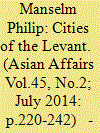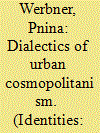| Srl | Item |
| 1 |
ID:
132342


|
|
|
|
|
| Publication |
2014.
|
| Summary/Abstract |
Global cities are almost by definition somewhat detached from their geographical hinterlands. Cosmopolitan and modern, they are open to external influences from other cultures and from overseas trade. But they are also vulnerable to the rise of nationalism in the country which surrounds them, as is shown by the fate of three famous cities of the Levant, Alexandria, Smyrna and Beirut. They were multicultural trading cities, linking the economies of Europe and Asia, "windows on the world", in contrast to inland capitals like Cairo Ankara and Damascus. New global cities like London, Hong Kong and Dubai also have hybrid and polyglot inhabitants, like Levantine cities of bygone days. But they will need support if their cosmopolitanism is to prevail over nationalism.
|
|
|
|
|
|
|
|
|
|
|
|
|
|
|
|
| 2 |
ID:
140441


|
|
|
|
|
| Summary/Abstract |
Cosmopolitan cities have been envisioned as colourful, aesthetically creative places at the centre of trade routes and empires, imaged in their bazaars and cafes, where spices and exotic objects are traded or avante-garde artistic and literary expatriates congregate. In the twenty-first-century world of accelerated migrations, cosmopolitan cities are made visible in the proliferation of ethnic restaurants and festivals. But despite their cultural heterogeneity, cosmopolitanism in cities remains a fragile achievement. Such cities have the potential, it seems, to erupt into violence or, on the contrary, to display an intercultural creativity that transects and transcends social divisions. Building on Humphries and Skvirskaja’s work on ‘post-cosmopolitan’ cities, the present paper compares Eastern Mediterranean cities historically famous for their cosmopolitanism like Istanbul and Thessalonika, contemporary post-Communist cities like Sarajevo or Odessa and twenty-first-century global cities like Cairo or London to ask: what makes these cities both cosmopolitan and anti-cosmopolitan?
|
|
|
|
|
|
|
|
|
|
|
|
|
|
|
|